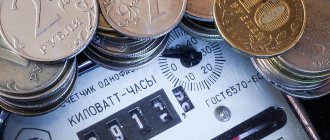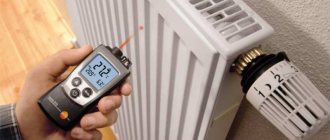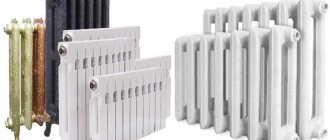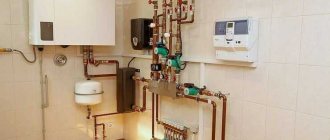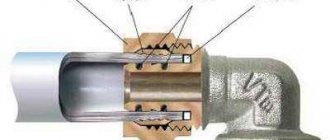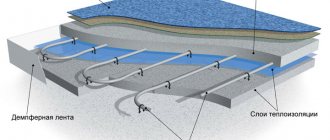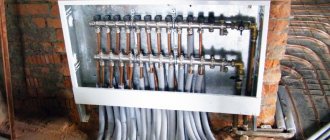Author of the article
Anton Bogdanov
Heat and gas supply and ventilation engineer. Prepares projects for gas supply to private houses.
Almost everyone has become accustomed to the fact that a meter for gas, electricity and water installed in an apartment helps save the budget. After all, thanks to metering devices, you can only pay for what you actually consume. But fewer people know that it is possible to install an apartment heat meter on heating pipes. The idea looks good, because in winter we pay serious sums for heating. Complete with the meter, you can install taps. They can regulate the level of heat entering the house so as not to swelter from the heat. You can practically turn off the heat supply if you are planning a long trip, and not have to pay for heating empty walls.
So what if you install a heating meter in your apartment? Will it help you save money? Let's try to answer all your questions in this article.
What the law says
The law in 2022 does not oblige the installation of individual heat energy meters in the apartment, but does not prohibit it either. In order to install a meter in an apartment, the meter must also be installed at the entrance to the building. According to Article 13, paragraph 5 of Federal Law No. 261-FZ of November 23, 2009, every apartment building must be equipped with a heat meter. So if the management company adheres to the law, then we can assume that the general building meter is installed by default.
Based on the law, Article 157 of the Housing Code of the Russian Federation, payment is made on the basis of a common building meter, and then the amount received is divided among all residents, taking into account the square footage of the apartment.
If the meter is also installed in the apartment, then the owner pays for the heat consumed by it and for general house consumption for heating the entrance, basement, or attic.
Is it profitable to install individual heat meters?
After you go through all the vicissitudes of paperwork, installation of a heat meter and its commissioning, you will receive the following benefits:
- payment for the heat used specifically by you, and not some average costs throughout the building;
- it will be possible to save thermal energy when it is not required;
- By investing money in insulating the walls of your apartment, you will not only protect your home from the cold, but you will also pay less for heating in fact.
The payback of the project depends on many factors, ranging from how much the heating meter and installation services cost. Practice shows that payment for the device is reduced by an average of 25-30% compared to the tariffs applied in the absence of heat meters.
Advice. There is a simple way to verify the benefits of organizing individual heat energy metering. Analyze how much you paid for centralized heating 2-5 years ago and track the trend in tariff growth. Note that rising energy prices will not stop in the future.
Such a thermal head allows you not only to regulate the temperature, but also to change it according to the time of day.
Controlling the actual heat consumption is the first step to saving it. The second is the installation of valves with thermal heads on batteries that limit the heating of air in rooms, which is described in detail in this article. If you buy programmable thermal heads, then during your absence the temperature in the rooms can be reduced by 3-4 °C. The third step is thermal insulation of walls and ceilings with floors (if necessary).
approximate cost
The most affordable radiator meters are mechanical devices; they can be purchased for about 3,500 rubles.
Ultrasonic devices are more expensive; their prices start at 4,000 rubles.
On average, popular models cost around 5,000 – 6,000 thousand rubles.
When choosing a radiator meter, you need to know the diameter of the pipe on which the device will be installed. The thicker the pipe, the higher the cost of a heat meter suitable for it.
Typically the kit includes a calculator, a flow meter and a pair of sensors for the supply and return pipes. Additionally, you will have to purchase some parts:
- mechanical cleaning filter for the flow meter - 300 rubles;
- tee for connecting a temperature sensor – 800 rubles for 2 pieces;
- shut-off valve to shut off the flow of water - 500 rubles for 2 pieces;
- valve for regulating water flow - 1000 rubles for 2 pieces.
In almost any city there is a company that installs heat meters. Its representatives will help prepare the project, carry out installation and commission the device. Depending on the complexity and volume of work, the price for such services will range from 2,000 to 7,000 rubles.
In total, if you calculate the approximate cost of installing a meter, it comes out to 4,500 for the meter, 2,500 for additional parts and 4,000 rubles for the project and installation. It turns out 11,000 rubles.
If the house uses a vertical heating supply system, then a heat meter must be installed on each riser. In other words, you will have to install a thermal energy meter in each room, which will inevitably lead to an increase in the payback period.
For example, for a three-room apartment you will have to install a meter in all three rooms and in the kitchen, it turns out that instead of one device you will have to pay for four, and, accordingly, the payback of such a system will increase four times.
It is also worth considering that for corner apartments, where two walls in the room are external, radiators are installed on each wall, and accordingly in such a room there may be not one, but two risers, and you will have to install a meter on each heating radiator.
In connection with all these inconveniences caused by the vertical arrangement of pipes, heat distributors were invented. The cost of the device is 1000 rubles, installation 500 - 1000 rubles per piece. Thus, for a three-room room you will need 4 such distributors, this is 4000 rubles, 3000 for their installation and 500 rubles for shut-off valves or a valve for each battery, this is another 2000 rubles. This results in 10,000 rubles, which is comparable to installing one heat meter in a system with horizontal heat distribution.
Product selection criteria
When choosing a thermal product, you need to focus not only on the cost and advertising description, but also on the operation of heat meters. However, they must meet the following characteristics:
- Water measurement range;
- Hydraulic losses after installation of the device. The diameter of the channel behind the meter should not be less than that before the device;
- Saving money. The cost of the product and all components required for installation;
- The prevalence of this device in the region of residence, reviews about it;
- Service of the selected counter.
Types of heat metering devices
Important. Without the appropriate certificate for the device, the management company will not take the product into operation, so when purchasing, be sure to request this document from the distributor.
In addition to the above parameters, such indicators of devices as the coolant inlet circuit and the working fluid itself are important for specialists, and they also need to know the limit values of the existing parameters for this coolant.
An important factor when choosing a device to be installed in an apartment is the model and cost of the selected product:
| Model | Type | Flow (nominal) | Market average cost, rub. |
| Engelmann Sensostar 2 | Electromechanical | From 1.5 to 2.5 m3/hour | 13 185 |
| Engelmann Sensostar 2U | Ultrasonic | From 1.5 to 2.5 m3/hour | 15 300 |
| Landis&Gir T-230 | Ultrasonic | From 1.5 to 2.5 m3/hour | 15 300 |
| Landis&Gir T-550 | Ultrasonic | From 0.6 to 2.5 m3/hour | 17 680 |
| Landis&Gir T-2WR6 | Ultrasonic | From 0.6 to 2.5 m3/hour | 17 600 |
| Apator ELF | Electromechanical | From 0.6 to 2.5 m3/hour | 12 300 |
Comparison table of popular models and prices
Is it profitable to install IPU heat in an apartment?
Knowing the average price for installing a meter in an apartment is 11,000 rubles, you can estimate the approximate benefits. The price for installing distributors on batteries will be similar. According to calculations by heating engineers, savings on payments for consumed thermal energy average 30%.
For example, let’s take a three-room apartment with an area of 57 sq.m. The amount billed according to the standards for apartments with central heating is calculated based on the following parameters:
- Tariff for thermal energy. It is calculated in rubles per 1 Gcal. Set by government and varies by region;
- Consumption standard. Varies by region and varies by month;
- Square meters of living space.
For example, let’s take an apartment located in central Russia. The tariff for thermal energy in apartment buildings is about 1,900 rubles per 1 Gcal, and the consumption standard is 0.025 Gcal per sq.m. Thus, we get 1900 * 0.022 = 41.8 rubles. This is the price per 1 sq.m. multiply it by 57 squares and get an amount equal to 2382.6 rubles. This is how much you will need to pay per month for an apartment with a total area of 57 sq.m.
In colder months, this figure will be higher, since the boiler room will heat the coolant to a higher temperature, and the consumption standard will increase. And in warm months the coefficient will decrease. Thus, in the warmest months the coefficient is around 0.017 (1841.1 rubles per month), and in the coldest months, of which there are more, 0.026 (2815.8 rubles per month).
To calculate, let’s take an amount equal to 2,400 rubles per month. Payment for heat in the middle zone is charged from November to May, that is, 7 months. And for 7 months on average you will have to pay 17,000 rubles.
If we consider that the savings when using an individual heat meter for an apartment are 30%, then in 1 year the savings can reach 17,000 * 0.3 = 5,100 rubles.
Provided that the system is horizontal (only one device is needed for the entire apartment), 10,000 - 11,000 rubles were spent on installing the meter; in an apartment of 57 square meters, the meter will pay for itself in 2 years.
If the apartment has vertical wiring, then you will have to install several IPUs, and then the payback period increases significantly.
It is also worth considering that the service life of the meter is 10 - 12 years. And verification will need to be done once every 4-6 years, and you will also have to pay for it. But even if we take all this into account, over 12 years the heat meter will help save 61,200 rubles. From this amount you will have to subtract the cost of installing the meter (10,000 rubles), and you will also have to verify it 2 times during operation, this is about 2000 rubles per verification. As a result, it turns out that over 12 years, apartment heat meters will help save about 47,000 rubles.
pros
- real savings on heat bills;
- temperature adjustment;
- possibility of shutting off the heating if it is not required.
Minuses
- Large one-time cash costs;
- The benefits will only become apparent after a few years;
- The need for periodic inspections.
Residential heat meter operating principle
We also recommend that you consider the benefits of a custom heat control system supplied to your home to reduce the cost of these costs. The best solutions to these savings will be found together as we look at the piping in your home.
Quarterly recording of thermal energy is possible only with a horizontal wiring system for heat supply!!! *
Call us or leave a request on the website, and our manager will contact you.
Our prices
| Installation cost 1 water meter | from 1700 rubles |
| Cost of replacing 1 water meter | from 1400 rubles |
| Meter installation cost | from 12,000 rubles |
| Meter replacement cost | from 7,000 rubles |
| Installing the first radiator | from 3200 rubles |
| Installing the first radiator with 2 1/2" | from 4200 rubles |
| Jumper | 1800 rubles |
| Installing the first radiator by replacing two 3/4" | from 4700 rubles |
| Jumper | 2000 rubles |
| Installing the first radiator by replacing two 1" taps | from 5000 rubles |
| Jumper | 2400 rubles |
How to find out if it is technically possible to install a personal heat meter
Before installing a heat meter for heating in an apartment, you need to take into account a number of factors that may complicate this process.
Is there a communal heat meter in an apartment building?
Initially, you need to make sure that the house has a collective metering device. According to current legislation, heat meters for heating in an apartment building must be installed without fail, otherwise you need to file a claim with the local management company.
However, there are situations (in very old houses) when it is technically impossible to install such a common house device. Then installing an IPU will also not work.
Vertical or horizontal layout
You also need to clarify what type of wiring is used in the house, and based on this, determine the advisability of installing a personal metering device. Most houses in Russia use a heating system made using vertical wiring. This means that each room in the apartment has its own riser to which the battery is connected.
Accordingly, there are many such risers in the house and it will be necessary to install apartment heat meters for each radiator. But this is unprofitable, so instead of meters, radiator heat distributors (calculators) are often installed on each of the batteries.
There are no problems with horizontal wiring; in such apartments there is one riser and all radiators are connected to it by horizontally laid pipes, so here you can install a heat meter on the supply pipe.
Apart from these restrictions, there are no longer any other obstacles to installing heat meters in an apartment. Is it possible that there is some special case associated with errors in the installation of the heating network.
Read how to calculate payments for heat meters.
Electromagnetic heating meter
This device is designed for calculating heat in large volumes. Capable of controlling the circulation of heating energy in large residential, industrial, commercial, office and other facilities. It works on the principle of changing electromagnetic pulses passed through the water column. For this purpose, the heat meter is equipped with an electromagnetic coil that generates the necessary fields: when water flows through the magnetic zone, it causes a current, the strength of which serves as the basis for the measurement.
Pros: reliable and accurate, compact, can monitor massive coolant flows without compromising readings, mounted on large diameter pipes.
Disadvantages: dependent on the electrical network (most often), requires regular maintenance, sensitive to electromagnetic surges from nearby equipment, works worse if there are iron inclusions in the water.
Which heat meter to choose for an apartment
There is a wide selection of heat meters for a variety of conditions. Here we also consider individual meters that are suitable in their capacity, size and design for use in an apartment.
Mechanical
Some of the simplest and, accordingly, cheapest meters are mechanical devices. Such counters are also called tachometers. Outwardly they resemble ordinary water meters, only with two wires, at the ends of which there are temperature sensors that determine the difference in temperature on the supply and return pipes. The meter itself consists of two parts: a mechanical water meter with blades, which cuts into the pipe, and an electronic computer unit.
pros
- Low cost
- Does not require connection to the electrical network;
- Easy installation on any type of pipe.
Minuses
- Verification every 4 years;
- They may fail due to water hammer.
For such a device, it is necessary to use a coarse filter.
An example of inexpensive mechanical devices is the Hephaestus counter. The price of the cheapest device, suitable for installation in small apartments with a coolant flow rate of no more than 0.6 cubic meters per hour, does not exceed 4,000 rubles. There are also more productive models with a throughput capacity of up to 1.5 cubic meters per hour and a price of 4,500 rubles. There are also modifications with a pulse output and a radio channel for connection to an automatic data collection system.
Ultrasonic
The principle of operation is similar to the previous type of meter, but instead of mechanical blades, an emitter and a receiver are used here, which are placed from each other at a strictly specified distance, and the coolant flow is measured using an ultrasonic signal.
Pros:
- Affordable price;
- Durability.
Minuses:
- Complex installation carried out in accordance with relevant standards;
- High requirements for coolant purity;
- Verification every 4 years;
- Can only be installed on straight horizontal pipes.
An inexpensive representative of ultrasonic meters is the ECO NOM meter. For example, model ECO NOM STU-15.2 QN-1.5 M3/H. The number 15 means the diameter of the pipe; there are other modifications, for example, for a 20 pipe. 1.5 is the throughput; you can choose another suitable model, for example, with the number 0.6 or 2.5.
Calculator (Distributor)
Calculators and distributors are used in small apartments or in apartments with vertical distribution of the heating system. The difference between them is that the calculator has more capabilities, for example, it can show heat consumption in kW/hour on its screen.
The devices do not require insertion into the heating system; they are simply installed on each radiator and configured accordingly based on the type of battery. The device consists of two thermal sensors that measure the temperature of the battery and air in the room, and an adapter that performs calculations. In order not to combine all the readings from all batteries manually, for some models of calculators you can purchase a controller that wirelessly summarizes the readings of all calculators.
Pros:
- Low price;
- Possibility of installation on any type of pipe;
- Verification every 10 years;
- Easy installation.
Minuses:
- Distributor data is taken into account only if at least 50% of apartments in an apartment building are equipped with such distributors.
- The error is around 10%;
- The need to summarize data from all devices (on models without a summing controller);
- Correct operation only on factory models of heating devices.
- Calculating payments is quite complicated; residents cannot calculate the amount themselves; this is done by the heat supplier based on the provided data from all apartments.
Despite the ease of installation of the computer, its installation must be carried out by a professional who will correctly configure the device for specific conditions of use.
For example, the PULSE distributor “URT-100”. It costs 1,000 rubles and is designed to work with coolant temperatures from 35 to 105 degrees Celsius, which means it is suitable for measuring heat in the heating system of an apartment building.
The device is mounted between the radiator sections using fasteners. The case has an LCD display that displays information about current energy consumption. The meter also maintains a data archive. Remote data collection is possible.
Ultrasonic thermal energy meter
This option does not contain moving mechanisms, therefore it is more durable and reliable. To obtain information, it uses the principle of propagation of ultrasonic vibrations - along and against the flow. Because of this, its design includes two components placed opposite each other (receiver and emitter). The interval between signal waves depends on the speed of fluid movement through the pipeline. The coolant flow is calculated based on the obtained time.
Pros: allows you to customize the individual supply of thermal energy, reliable, highly accurate, durable, pays off due to increased stability.
Disadvantages: extremely sensitive to contamination of the working fluid (even with relative purity of water it can give erroneous readings), in most cases it operates on a rechargeable battery, which must be changed/recharged in a timely manner.
Algorithm for legal installation of a heat meter
Before installing an individual heat meter, you need to follow the action algorithm step by step so as not to end up with a device that is not suitable for commissioning.
- Contacting the utility company. First of all, you need to contact the management company and discuss all the conditions for installing the meter. It happens that the management company resists installing an IPU for heat. But this is illegal, so this issue needs to be resolved immediately.
- Development of the project and its coordination with the management company. Next, you need to contact a certified company, which will draw up a project and estimate for the work. This company must have permission to install heat meters; a license to install a meter in an apartment is not required.
- Purchasing a device. Before purchasing a device, you need to know exactly which device is suitable for your existing heating system. Typically, all the necessary data for purchasing the correct device and consumables are given in the project with an estimate.
- Installation. Since installing a heat meter requires a connection to the centralized heating system, this work must be carried out by qualified workers. They will be able to connect the heat meter without disrupting the functioning of the system.
After installation is completed, you need to contact the representative office of the heat supply organization to install seals. And when the device is installed and sealed, you need to go back to the management company with all the documents.
How does a heat meter work, types and characteristics of these devices
For this reason, metering the consumption of thermal energy consumed is only possible by installing a separate meter for each radiator, which is not economically feasible. In this case, it is recommended to install a group meter either on the house as a whole, or on a separate entrance (although the latter option is used very rarely).
So, where to start installing a heat energy meter:
- It is necessary to obtain a document called technical conditions from a local organization engaged in the supply of thermal energy.
The technical specifications usually indicate the location and method of installation, requirements for the meter (conditional bore diameter, temperature range and other data), in addition, an installation diagram with certain regulatory requirements for certain dimensions must be attached.Project for installing a heat meter
- Based on the technical conditions, the homeowner himself has the right to decide which meter to install for heating, but making a choice on his own is not recommended.
The fact is that the next document that needs to be obtained is a project for installing a meter for metering the received thermal energy. The development of project documentation must be carried out by a company that has the appropriate license. Be prepared for the fact that it will take a significant amount of time to develop the project, and the cost of this document is commensurate with the price of the purchased meter.
But it’s worth paying tribute to the designers, in many cases they recommend the most suitable metering device for certain conditions, so it’s worth listening to their advice.
The main thing is not to make a mistake in choosing an organization that will develop a project for installing a heat meter; try to give preference to trusted companies that have real reviews.
- The developed project is subject to mandatory agreement with the heat supply organization.
Although, serious designers resolve all these issues themselves thanks to long-established working relationships, however, this may affect the cost of project development services. - Based on the received permits, you can already select a specific meter.
Usually it is possible to purchase 2-3 modifications from different manufacturers. - Installation work should be entrusted to certified companies. Independent installation of a heat meter or the services of dubious specialists can result in problems when putting the meter into operation.
- Upon completion of all installation work, the meter must be accepted by representatives of the heat resource supplier.
On average, the entire procedure associated with installing a heat energy meter can take 1-6 months, it all depends on the amount of money invested and the efficiency of all organizations involved.
Technical nuances and installation rules
Each central heating system requires its own meter and its own set of additional equipment. For systems with horizontal wiring, both mechanical and ultrasonic meters can be installed. Installation of a mechanical type meter is possible in almost any conditions; for the ultrasonic type there are a number of restrictions. Also, if there are a small number of batteries in the room and there is no desire to cut pipes, then you can install several computers. But there is a serious limitation here: calculating payments using such devices is only possible if more than half of the apartments in an apartment building are equipped with them.
But in an apartment with vertical wiring you will have to limit yourself to just using computers or distributors.
Due to the design features of such a system, installing a mechanical or ultrasonic meter is not profitable and is too cumbersome. Useful article? Rate and share with friends!
Mechanical (tachometer) heat meter
It has a rotary impeller and a recording mechanism that determines the number of rotations performed to calculate the volume of water passing through the pipes. The temperature of the coolant is recorded by an electronic module built into the body of the device. Data on the state of the water is supplied to it through two probes located at the inlet and outlet of the flow. The device is powered from an internal source. That is, this is a simple heat meter, in demand among private homeowners and apartment owners.
Pros: profitable and inexpensive device, quickly pays for itself, compact, small, with proper operation and regular maintenance, it has a long service life.
Cons: requires replaceable filters and constant monitoring, is sensitive to water quality and often clogs in the presence of foreign impurities (scale, scale, rust).
How is the payment amount calculated?
The consumer can independently calculate the amount to pay. The calculation is made using the following formula:
We recommend: How much electricity does a fan consume?
Sp = (Pt – Pp)*T
wherein:
- Sp – payment amount;
- Pt – current readings of the IPU;
- Pp – previous readings;
- T – tariff assigned for a specific region for a given type of resource.
When taking readings, leading zeros and the fractional value of the consumed volume are not taken into account (fractional values are located after the decimal point or period). It is necessary to limit yourself to a five-digit number, even if the readings represent a larger number of digits of an integer value.
For example:
- You need to write out the readings located in the green frame (at the beginning and end of the month);
- Find the difference (end of month - (minus) beginning of month);
- Multiply the tariff (electricity, gas or water) by the difference.
Installation procedure
Individual metering devices are installed by resource suppliers. To do this, the consumer needs to prepare a corresponding application to the city gas, water utility or energy supply with the corresponding request.
Upon request, a specialist from the organization will be sent to install the meter. The device is purchased by the consumer independently or offered by the company, with the subsequent submission of an invoice to compensate for the cost of the product.
We recommend: How to choose a box for an electricity meter

